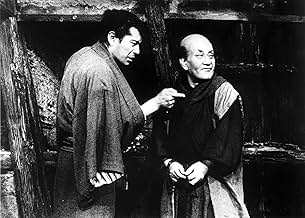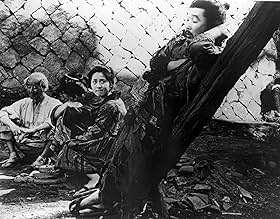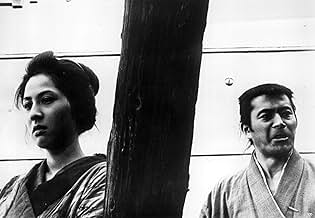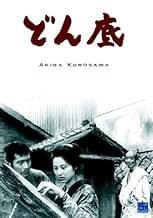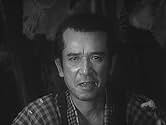IMDb RATING
7.2/10
6.3K
YOUR RATING
In a Japanese slum, various residents play out their lives, dreaming of better things or settling for their lot. Among them is a man who pines for a young woman but is stymied by her decepti... Read allIn a Japanese slum, various residents play out their lives, dreaming of better things or settling for their lot. Among them is a man who pines for a young woman but is stymied by her deceptive family.In a Japanese slum, various residents play out their lives, dreaming of better things or settling for their lot. Among them is a man who pines for a young woman but is stymied by her deceptive family.
- Director
- Writers
- Stars
- Awards
- 5 wins total
Kamayuki Tsubono
- Tradesman
- (uncredited)
- Director
- Writers
- All cast & crew
- Production, box office & more at IMDbPro
Featured reviews
10davidals
LOWER DEPTHS perhaps isn't the place to start if you're completely unfamiliar with Kurosawa - but it still ranks as one of his great films, and definitely one of his most underrated.
Based on a Maxim Gorky play (an earlier Jean Renoir film draws upon the same source material), LOWER DEPTHS seems a bit stagey at first, but Kurosawa manages to enliven it considerably - the performances are all top-notch, and the combination of skillful editing (straight cuts only here, but the usual Kurosawa multi-camera shooting method) and inventive set design (with diagonals and angles trapping characters, heighetning the intensity of the dialogue and acting) making this an unforgettable film to watch - easily as accomplished as the better known THRONE OF BLOOD from a little earlier. One will definitely note how tightly constructed - in all ways - this film is.
This film does (along with IKIRU, RED BEARD and HIGH & LOW) illuminate some of Kurosawa's underlying philosophies, specifically a sense of social realism in cinema that can cast a critical gaze upon injustice, and in this film a sense of anger and frustration is articulated with an unusual degree of eloquence, testament to both Kurosawa's technical virtuosity, and his greater awareness of the world.
But for all of the cruelty on display here, there's an equal amount of humor, typically irreverent and loaded with sly social commentary, but also spontaneous: the two impromptu musical episodes, which blend Japanese theatrical conventions with a Chaplin-like sense of visual choreography to very striking effect.
Not as well known as SEVEN SAMURAI, THRONE OF BLOOD or YOJIMBO, but just as accomplished - filled with delight and insight.
Based on a Maxim Gorky play (an earlier Jean Renoir film draws upon the same source material), LOWER DEPTHS seems a bit stagey at first, but Kurosawa manages to enliven it considerably - the performances are all top-notch, and the combination of skillful editing (straight cuts only here, but the usual Kurosawa multi-camera shooting method) and inventive set design (with diagonals and angles trapping characters, heighetning the intensity of the dialogue and acting) making this an unforgettable film to watch - easily as accomplished as the better known THRONE OF BLOOD from a little earlier. One will definitely note how tightly constructed - in all ways - this film is.
This film does (along with IKIRU, RED BEARD and HIGH & LOW) illuminate some of Kurosawa's underlying philosophies, specifically a sense of social realism in cinema that can cast a critical gaze upon injustice, and in this film a sense of anger and frustration is articulated with an unusual degree of eloquence, testament to both Kurosawa's technical virtuosity, and his greater awareness of the world.
But for all of the cruelty on display here, there's an equal amount of humor, typically irreverent and loaded with sly social commentary, but also spontaneous: the two impromptu musical episodes, which blend Japanese theatrical conventions with a Chaplin-like sense of visual choreography to very striking effect.
Not as well known as SEVEN SAMURAI, THRONE OF BLOOD or YOJIMBO, but just as accomplished - filled with delight and insight.
The Criterion Collection offers two different film versions of "The Lower Depths": one made in 1936 by Jean Renoir and another one made in 1957 by Kurosawa. The two directors never worked together on either film. In fact, they only met once in their lives, many years later. Both films are based on Russian writer Maxim Gorky's 1902 play, which describes life in a miserable slum where most characters have lost all sense of hope. Renoir deals with this serious subject matter in a much more humorous and amusing way than Kurosawa, whose film is slower, decidedly somber and a lot more difficult to digest. While Renoir's work takes the viewer in and out of the slums, Kurosawa doesn't allow one to see beyond the wretchedness of the underworld. Both films are great, but it was probably Kurosawa's which left a more durable and deeper impression on me.
Without it being one of Akira Kurosawa's finest, The Lower Depths is an exceptional film. As with any Kurosawa film it is wonderfully made, with well-crafted sets and fine use of camera work. Kurosawa directs superbly, always with a delicate touch while giving detail and humanity to his stories and characters. And those they do here. The story has a lot of intensity and unsentimental in its telling of lives without hope, and the characters are powerfully written with a lot of humanity. The ensemble playing is really magnificent with the standouts being Toshiro Mifune, charismatic as ever, and Kamatari Fujiwara, who conveys an astonishing range of emotions here. My only real criticism of The Lower Depths is the rather abrupt ending, other than that it is a really well-done film with a lot of things to like about Kurosawa's films present. 9/10 Bethany Cox
First, I must provide the obligatory warning that this film is absolutely not a good film for introducing a viewer to the power of Kurosawa. Nevertheless, this film is one of his most well-crafted ensemble films. The performance of Bokuzen Hidari as the wandering pilgrim or priest Kahei is his pinnacle in Kurosawa's films. After his comic-relief roles in the more well known films "Ikiru" and "Seven Samurai", this role is Hidari's chance to show his own version of wisdom and authority. Similarly, Kamatari Fujiwara's powerfully sympathetic performance as the alcoholic actor is another surprising demonstration by an actor who had, hitherto, been cast in unsympathetic- even adversarial roles in previous Kurosawa films. As one comes to expect from Isuzu Yamada, her character is a feisty and commanding presence that drives the plot along.
Toshiro Mifune, however, was not the best choice for his role as the petty thief- try as he might to look like a immature and puerile common criminal , the false swagger fails to hide the actor's inherent dignity. Nevertheless, his energy and effort still make his performance believable- if incongruous. In general, however, his unsuitability for his role is the only significant snag in an otherwise fluid and natural performance on the part of all the actors. Also, the sets, as one would expect for Kurosawa, are meticulously detailed, well-lit, and authentic-seeming.
The story- based on the Maxim Gorky play, however, is not that compelling. In part, I think, it is my reaction to a socialistic morality play brought to the silver screen. Also, however, Kurosawa has tried too hard and has polished the performance and settings for too long. As well and smoothly as the actors interact, as convincing they are in their roles, their performance just does not lead anywhere dramatically. However, I saw the Jean Renoir version- a much less refined effort, in my opinion- and had much the same reaction, concluding that the story, itself, and not Kuroasawa's over-controlling treatment is what hampered my engagement.
In spite of that... That is to say... In spite of the fact that the movie's story is not very compelling for me at all, I still have high regard for the film because the acting performances are so solid and engaging. For that reason, I strongly urge devotees of Kurosawa's films to check this movie out at some point while keeping in mind that it remains less than a sum of its parts.
Toshiro Mifune, however, was not the best choice for his role as the petty thief- try as he might to look like a immature and puerile common criminal , the false swagger fails to hide the actor's inherent dignity. Nevertheless, his energy and effort still make his performance believable- if incongruous. In general, however, his unsuitability for his role is the only significant snag in an otherwise fluid and natural performance on the part of all the actors. Also, the sets, as one would expect for Kurosawa, are meticulously detailed, well-lit, and authentic-seeming.
The story- based on the Maxim Gorky play, however, is not that compelling. In part, I think, it is my reaction to a socialistic morality play brought to the silver screen. Also, however, Kurosawa has tried too hard and has polished the performance and settings for too long. As well and smoothly as the actors interact, as convincing they are in their roles, their performance just does not lead anywhere dramatically. However, I saw the Jean Renoir version- a much less refined effort, in my opinion- and had much the same reaction, concluding that the story, itself, and not Kuroasawa's over-controlling treatment is what hampered my engagement.
In spite of that... That is to say... In spite of the fact that the movie's story is not very compelling for me at all, I still have high regard for the film because the acting performances are so solid and engaging. For that reason, I strongly urge devotees of Kurosawa's films to check this movie out at some point while keeping in mind that it remains less than a sum of its parts.
Kurosawa meant this to be a fairly straightforward filming of the Gorky play and it is. Like most filmed stage plays, it relies heavily on dialogue and a good translation for people who don't speak Japanese. Fortunately, the new Criterion DVD supplies this. You have to get some appreciation for the characters before this film comes alive, which it did for me about half way through. I watched it again and greatly enjoyed the entire film. Unlike the French version with Jean Gabin, Kurosawa does not single out any one character as the focus, which is not easy with Mifune in the picture. (He is not in the last quarter of the film). At first, we seem to have only a mob of quarrelsome boarders in a flophouse, but the personality of each one gradually emerges--the gambler, the actor, the barrel maker, the thief, the prostitute, the former samurai, the priest. Each one alternately harangues and supports the other boarders, while trying to maintain some shred of dignity to themselves. I would not recommend it as an introduction to Kurosawa (try Ikiru or Red Beard) but give it a try. 4 out of 5.
Did you know
- TriviaThe entire film was shot mostly in sequence and was finished in about four weeks.
- Quotes
Sutekichi the Thief: Lies trump the truth every time.
- ConnectionsFeatured in 62nd Annual Academy Awards (1990)
- How long is The Lower Depths?Powered by Alexa
Details
- Release date
- Country of origin
- Language
- Also known as
- The Lower Depths
- Filming locations
- Toho Studios, Tokyo, Japan(Studio)
- Production company
- See more company credits at IMDbPro
- Runtime2 hours 17 minutes
- Color
- Sound mix
- Aspect ratio
- 1.37 : 1
Contribute to this page
Suggest an edit or add missing content

